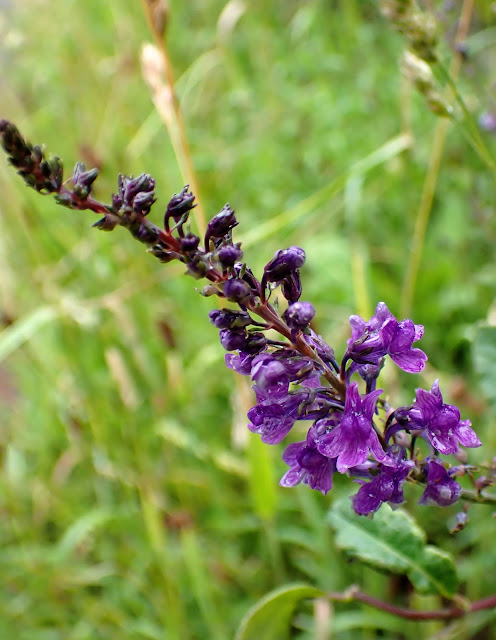- Common Toadflax, Linaria vulgaris is the only native here.
- Purple Toadflax, Linaria purpurea was introduced to gardens from Italy and recorded in the wild from around 1830.
- Ivy-leaved Toadflax Cymbalaria muralis was probably an accidental introduction on imported marble slabs from Italy and recorded in the wild and spreading by 1640.
Common Toadflax, Linaria vulgaris
This distinctive, showy yellow spike was on a rough grassy track verge near Woolhampton, Berkshire. It is supposedly very common but I rarely see it. There were only two spikes about two feet apart but enough! The blooms are snap dragon-like, 2 lipped, yellow with a large orange-yellow boss on the lower lip; the spur is more or less straight.
The apothecaries' name was Urinalis as the colour suggested urine. It was used as a diuretic and presumably the colour also suggested it as a treatment for jaundice. During its long history in herbal medicine the leaves were used to make a laxative tea and an ointment for skin diseases.
Purple Toadflax, Linaria purpurea
A common garden escape. This one probably is such on a village bank near Monmouth. The tall slender spikes of snapdragon-like flowers are distinctive. There are darker purplish veins on the corolla. The stems are usually purplish and leaves strap shaped. The lower leaves grow in whorls.
This is likely to have been imported to London in 1640 on Italian marble slabs. As garden walls went up apace in the next 300 years it was a good time for a species that likes growing between rocks and stones. It acquired the name Oxford Weed because it became so well established on the walls of Oxford colleges. It was popular as an ornamental up to the end of the nineteenth century but is no longer deliberately planted. These photographs were taken in Abergavenny and my garden.
The leaves are glossy and usually 5 lobed with palmate veins. Solitary flowers are lilac (I have seen white ones in St David's, Pembrokeshire) with a yellow spot. There is a short curved spur. They are solitary in the leaf axils.
The flower stalks bend towards the light, but as the fruit develops the stalks gradually recurve towards the growing surface so the seeds can lodge in any likely space or crack and establish a new plant. I hope this can be seen happening below. It certainly explains, along with some rooting at lower nodes, the successful spread of this plant.
The Latin name Cymbalaria refers to the shape of the leaves which were thought to resemble cymbals. Local names include Creeping Jenny, Mother of Millions and Nanny Goat's Mouths in Devon alone.
It tastes like watercress and has been eaten in salads and the flowers give a clear but not permanent yellow dye.
Thank you for reading. I hope you have found out something new about these common, well known plants.
Harrap's Wild Flowers
Stace 4
The Englishman's Flora Grigson
Flora Britannica Richard Mabey
https://www.plantlife.org.uk/uk
http://seasonalwildflowers.com/



































